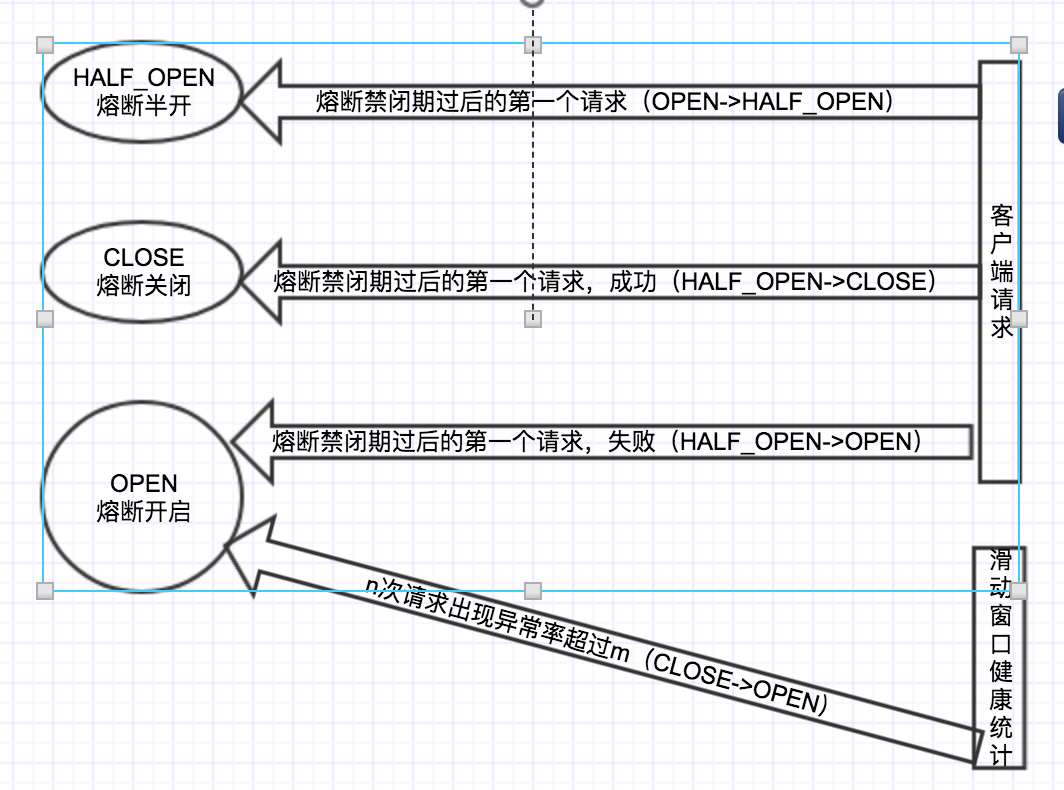жӮЁеҘҪпјҢзҷ»еҪ•еҗҺжүҚиғҪдёӢи®ўеҚ•е“ҰпјҒ
иҝҷжңҹеҶ…е®№еҪ“дёӯе°Ҹзј–е°Ҷдјҡз»ҷеӨ§е®¶еёҰжқҘжңүе…іspring cloudдёӯHystrixжҢҮж Ү收йӣҶеҺҹзҗҶжҳҜд»Җд№ҲпјҢж–Үз« еҶ…е®№дё°еҜҢдё”д»Ҙдё“дёҡзҡ„и§’еәҰдёәеӨ§е®¶еҲҶжһҗе’ҢеҸҷиҝ°пјҢйҳ…иҜ»е®ҢиҝҷзҜҮж–Үз« еёҢжңӣеӨ§е®¶еҸҜд»ҘжңүжүҖ收иҺ·гҖӮ
дёҠдёҖзҜҮд»Ӣз»ҚдәҶhystrixзҶ”ж–ӯйҷҚзә§зҡ„еҹәжң¬е®һзҺ°еҺҹзҗҶпјҢзқҖйҮҚзӮ№жҳҜд»ҺhystrixиҮӘиә«зҡ„иғҪеҠӣж–№йқўзқҖжүӢпјҢз»“еҗҲд»Јз ҒпјҢеҒҡдәҶж•ҙдҪ“д»Ӣз»ҚпјҢйӮЈд№Ҳи§ҰеҸ‘зҶ”ж–ӯзҡ„жҢҮж ҮжҳҜеҰӮдҪ•и®Ўз®—зҡ„пјҢеҸҜиғҪеүҚйқўдјҡз¬јз»ҹзҡ„жҸҗеҲ°metricsпјҢиҮідәҺе®ғзҡ„metricsе®һзҺ°еҺҹзҗҶжҳҜжҖҺд№Ҳж ·зҡ„пјҢеңЁжң¬з« еҒҡйҮҚзӮ№д»Ӣз»Қ
е®ҳж–№еӣҫзӨәпјҡ

еҜ№дәҺдҪҝз”ЁиҖ…е…Ҳжһ„йҖ дёҖдёӘHystrixCommandеҜ№иұЎжҲ–иҖ…HystrixObservalbeCommand
йҖүжӢ©queueжҲ–иҖ…executeпјҢи°ғз”ЁиҖ…еҶіе®ҡжҳҜдҪҝз”ЁејӮжӯҘиҝҳжҳҜеҗҢжӯҘж–№ејҸ
ж №жҚ®commandKeyзңӢзј“еӯҳдёӯжҳҜеҗҰеӯҳеңЁObservalbeпјҢејҖеҗҜзј“еӯҳжҳҜдёәдәҶжҸҗеҚҮжҖ§иғҪпјҢзӣҙжҺҘиҝ”еӣһиҫ“еҮә
жІЎжңүзј“еӯҳпјҢйӮЈе°ұејҖе§Ӣиө°зҶ”ж–ӯеҷЁзҡ„йҖ»иҫ‘пјҢе…ҲеҲӨж–ӯзҶ”ж–ӯеҷЁжҳҜдёҚжҳҜејҖеҗҜзҠ¶жҖҒ
зҶ”ж–ӯеҷЁејҖеҗҜпјҢи§ҰеҸ‘еҝ«йҖҹеӨұиҙҘпјҢи§ҰеҸ‘йҷҚзә§пјҢеҺ»жү§иЎҢз”ЁжҲ·жҸҗдҫӣзҡ„fallback()йҖ»иҫ‘
еҲӨж–ӯжҳҜдёҚжҳҜ并еҸ‘и¶…йҷҗпјҢи¶…йҷҗпјҢи§ҰеҸ‘йҷҚзә§пјҢеҲҷеҸ‘еҮәжү§иЎҢжӢ’з»қзҡ„ејӮеёёпјҢеҺ»жү§иЎҢз”ЁжҲ·жҸҗдҫӣзҡ„fallbackйҖ»иҫ‘
жү§иЎҢз”ЁжҲ·е®һзҺ°зҡ„е…·дҪ“дёҡеҠЎйҖ»иҫ‘пјҢжҳҜеҗҰеҮәзҺ°жү§иЎҢејӮеёёжҲ–иҖ…и¶…ж—¶пјҢејӮеёёжҲ–и¶…ж—¶пјҢеҲҷи§ҰеҸ‘йҷҚзә§еҺ»жү§иЎҢз”ЁжҲ·жҸҗдҫӣзҡ„fallbackйҖ»иҫ‘
жү§иЎҢз»“жқҹ
ж— и®әжҳҜжӯЈеёёз»“жқҹиҝҳжҳҜжү§иЎҢејӮеёёпјҢйғҪдјҡи§ҰеҸ‘metricsзҡ„收йӣҶпјҢ收йӣҶзҡ„з»“жһңз»ҸиҝҮи®Ўз®—еҗҺпјҢжҸҗдҫӣз»ҷзҶ”ж–ӯеҷЁпјҢеҒҡејҖеҗҜе’Ңе…ій—ӯзҡ„еҶізӯ–
иҝҷйғЁеҲҶжҲ‘们йңҖиҰҒд»Һд»ҘдёӢеҮ дёӘж–№йқўеҒҡеҲҶжһҗпјҡжҢҮж ҮдёҠжҠҘгҖҒжҢҮж Үи®Ўз®—гҖҒжҢҮж ҮдҪҝз”ЁпјҢиҝҷжңҹй—ҙдјҡж¶үеҸҠеӨҡзәҝзЁӢзҡ„并еҸ‘еҶҷе…ҘгҖҒж¶ҲжҒҜзҡ„йЎәеәҸеҲ°иҫҫгҖҒж»‘еҠЁзӘ—еҸЈзҡ„е®һзҺ°зӯүзӯү
жҢҮж ҮдёҠжҠҘ
жҜҸдёҖдёӘиҜ·жұӮзәҝзЁӢпјҢйғҪдјҡеҲӣе»әдёҖдёӘExecutionResultе®һдҫӢпјҢиҝҷдёӘе®һдҫӢдјҡе…іиҒ”дёҖдәӣеҹәзЎҖдәӢ件жҜ”еҰӮејҖе§Ӣж—¶й—ҙгҖҒжү§иЎҢ延иҝҹгҖҒдәӢ件з»ҹи®ЎзӯүеҹәзЎҖдҝЎжҒҜпјҢд№ҹе°ұжҳҜеңЁж•ҙдёӘhystrixзҡ„з”ҹе‘Ҫе‘ЁжңҹйҮҢйқўпјҢдјҡйҖҡиҝҮжҢҮж ҮдёҠжҠҘзҡ„ж–№ејҸеҒҡж•°жҚ®зҡ„收йӣҶпјҢдёӢйқўзңӢдёӢж•°жҚ®дёҠжҠҘзҡ„еҮ дёӘдәӢ件пјҡ
1.1гҖҒexecutionResult = executionResult.setInvocationStartTime(System.currentTimeMillis());//еҲӨж–ӯж–ӯи·ҜеҷЁжңӘејҖеҗҜпјҢ并еҸ‘жңӘи¶…йҷҗпјҢи®°еҪ•жү§иЎҢзҡ„ејҖе§Ӣж—¶й—ҙ
1.2гҖҒexecutionResult = executionResult.addEvent((int) latency, HystrixEventType.SUCCESS);//жү§иЎҢжҲҗеҠҹдјҡеўһеҠ successзҡ„дәӢ件е’ҢиҖ—ж—¶
1.3гҖҒHystrixEventType.SHORT_CIRCUITED//ж–ӯи·ҜеҷЁжү“ејҖпјҢдјҡ收йӣҶеҝ«йҖҹзҶ”ж–ӯзҡ„дәӢ件е’ҢиҖ—ж—¶
1.4гҖҒHystrixEventType.SEMAPHORE_REJECTED//дҝЎеҸ·йҮҸж–№ејҸ并еҸ‘ж•°и¶…йҷҗпјҢдјҡи®°еҪ•иҜҘдәӢ件е’ҢиҖ—ж—¶
1.5гҖҒHystrixEventType.THREAD_POOL_REJECTED//зәҝзЁӢжұ дёҚеҸҜз”ЁпјҲ并еҸ‘и¶…йҷҗпјүпјҢдјҡи®°еҪ•иҜҘдәӢ件е’ҢиҖ—ж—¶
1.6гҖҒHystrixEventType.TIMEOUT//жү§иЎҢи¶…ж—¶пјҢдјҡ收йӣҶиҜҘдәӢ件е’ҢиҖ—ж—¶
1.7гҖҒHystrixEventType.BAD_REQUEST//еҸӮж•°жҲ–зҠ¶жҖҒејӮеёёпјҢдјҡ收йӣҶиҜҘдәӢ件е’ҢиҖ—ж—¶
д»ҘдёҠж•ҙдҪ“зҡ„дәӢ件еҲҶдёәдёӨеӨ§зұ»пјҢжҲҗеҠҹе’ҢеӨұиҙҘпјҢж №жҚ®з”ЁжҲ·йҖ»иҫ‘д»Јз Ғзҡ„жү§иЎҢз»“жһңпјҢеҰӮжһңжҳҜжңүејӮеёёпјҢ收йӣҶејӮеёёдәӢ件е’ҢиҖ—ж—¶пјҢжү§иЎҢcircuitBreaker.markNonSuccess()пјҢеҗҰеҲҷжү§иЎҢcircuitBreaker.markNonSuccess()
еҸҰеӨ–и§ҰеҸ‘зҶ”ж–ӯеҷЁејҖеҗҜе’Ңе…ій—ӯпјҢжңүдё”еҸӘжңүдёӨдёӘйҖ”еҫ„пјҢеҰӮдёӢеӣҫпјҡ

жҢҮж Үи®Ўз®—

иҝҷйҮҢз®ҖеҚ•еҜ№еҗ„дёӘжӯҘйӘӨдёӯж¶үеҸҠеҲ°еӨҡзәҝзЁӢ并еҸ‘зҡ„жғ…еҶөд»ҘеҸҠж»‘еҠЁзӘ—еҸЈзҡ„и®Ўз®—еҒҡдёҖдёӘз®ҖеҚ•д»Ӣз»Қпјҡ
2.1пјҡ并еҸ‘пјҲthreadLocal&SerializedSubjectпјү
еҗҢдёҖдёӘжҺҘеҸЈж”¶еҲ°еӨҡдёӘиҜ·жұӮж—¶еҖҷпјҢд№ҹе°ұжҳҜиҝҷдәӣиҜ·жұӮе‘Ҫдёӯзҡ„йғҪжҳҜеҗҢдёҖдёӘcommandKeyж—¶пјҲз»ҹи®ЎжҢҮж ҮжҳҜжҢүз…§KEYдёәз»ҙеәҰпјүпјҢжҜҸдёӘиҜ·жұӮйғҪжҳҜдёҖдёӘзӢ¬з«Ӣзҡ„зәҝзЁӢпјҢжҜҸдёӘзәҝзЁӢеҶ…дјҡдә§з”ҹеӨҡдёӘеҗ„з§Қеҗ„ж ·зҡ„дәӢ件пјҢйҰ–е…ҲеҗҢдёҖдёӘзәҝзЁӢеҶ…зҡ„eventжӢјжҺҘе°ҒиЈ…жҲҗHystrixCommandCompletionпјҢдёҠжҠҘзҡ„жҳҜдёҖдёӘHystrixCommandCompletionпјҢжөҒи®Ўз®—ж“ҚдҪңзҡ„д№ҹжҳҜдёҖдёӘдёӘзҡ„HystrixCommandCompletionпјҢдёҚеӯҳеңЁи®Ўз®—ж—¶еҖҷжҠҠеҗ„зәҝзЁӢзҡ„дәӢ件混жқӮеңЁдёҖиө·зҡ„еҸҜиғҪпјҢеҰӮдҪ•дҝқиҜҒзҡ„еңЁдёӢйқўдјҡи®ІеҲ°
2.1.1пјҡдёҠжҠҘиҖ…жҳҜйҖҡиҝҮthreadLocalзәҝзЁӢйҡ”зҰ»
йҰ–е…ҲhystrixеҗҜеҠЁеҗҺдјҡеҲӣе»әдёҖдёӘthreadLocalпјҢеҪ“дёҖдёӘе®ўжҲ·з«ҜиҜ·жұӮдёҚз®ЎжҳҜжӯЈеёёз»“жқҹиҝҳжҳҜејӮеёёз»“жқҹпјҢйғҪиҰҒдёҠжҠҘдёҠжҠҘзҠ¶жҖҒпјҢд№ҹе°ұжҳҜжү§иЎҢhandleCommandEndпјҢйғҪдјҡд»ҺthreadLocalдёӯиҝ”еӣһдёҖдёӘеҪ“еүҚзәҝзЁӢзҡ„HystrixThreadEventStream,д»Јз ҒеҰӮдёӢпјҡ
private void handleCommandEnd(boolean commandExecutionStarted) {
//зңҒз•ҘйғЁеҲҶд»Јз Ғ
if (executionResultAtTimeOfCancellation == null) {
//дёҠжҠҘmetrics
metrics.markCommandDone(executionResult, commandKey, threadPoolKey, commandExecutionStarted);
} else {
metrics.markCommandDone(executionResultAtTimeOfCancellation, commandKey, threadPoolKey, commandExecutionStarted);
}
} void markCommandDone(ExecutionResult executionResult, HystrixCommandKey commandKey, HystrixThreadPoolKey threadPoolKey, boolean executionStarted) {
//threadLocalдёӯж”ҫзҪ®зҡ„жҳҜHystrixThreadEventStreamпјҢеӣ дёәж”№еҶҷдәҶinitж–№жі•пјҢжүҖд»Ҙж— йңҖsetпјҢзӣҙжҺҘеҸҜд»ҘиҺ·еҸ–
HystrixThreadEventStream.getInstance().executionDone(executionResult, commandKey, threadPoolKey);
if (executionStarted) {
concurrentExecutionCount.decrementAndGet();
}
}
//д»ҺthreadLocalдёӯиҺ·еҸ–дәӢ件жөҒ
public static HystrixThreadEventStream getInstance() {
return threadLocalStreams.get();
}
//threadLocalзҡ„е®ҡд№үпјҢж”№еҶҷдәҶinitж–№жі•пјҢжүҖд»ҘдёҚз”ЁеҚ•зӢ¬и°ғз”Ёset
private static final ThreadLocal<HystrixThreadEventStream> threadLocalStreams = new ThreadLocal<HystrixThreadEventStream>() {
@Override
protected HystrixThreadEventStream initialValue() {
return new HystrixThreadEventStream(Thread.currentThread());
}
}2.1.2пјҡйҷҗжөҒйҳҹеҲ—
жҜҸдёӘзәҝзЁӢдјҡжңүе”ҜдёҖзҡ„HystrixThreadEventStreamпјҢеӣ дёәжҳҜд»ҺtheadLocalиҺ·еҸ–пјҢжҜҸдёӘHystrixThreadEventStreamйғҪдјҡе…іиҒ”дёҖдёӘз”ұSubjectе®һзҺ°зҡ„йҳҹеҲ—пјҢд№ҹе°ұжҳҜжҜҸдёҖдёӘзәҝзЁӢйғҪжңүдёҖдёӘз§Ғжңүзҡ„йҳҹеҲ—пјҢиҝҷйҮҢиҜҙе®ғжҸҗдҫӣйҷҗжөҒжҳҜеӣ дёәйҮҮз”ЁдәҶвҖҳиғҢеҺӢвҖҷзҡ„еҺҹзҗҶпјҢжүҖи°“зҡ„вҖҳиғҢеҺӢвҖҷжҳҜжҢҮжҢүйңҖжҸҗдҫӣпјҢж №жҚ®ж¶Ҳиҙ№иҖ…зҡ„иғҪеҠӣеҺ»еҫҖйҳҹеҲ—з”ҹдә§пјҢд»Јз ҒеҰӮдёӢпјҡ
public void executionDone(ExecutionResult executionResult, HystrixCommandKey commandKey, HystrixThreadPoolKey threadPoolKey) {
//жҠҠexecutionResultе°ҒиЈ…жҲҗHystrixCommandCompletionпјҢHystrixCommandCompletionжҳҜжөҒи®Ўз®—ж“ҚдҪңзҡ„еҹәжң¬еҚ•дҪҚ
HystrixCommandCompletion event = HystrixCommandCompletion.from(executionResult, commandKey, threadPoolKey);
//writeOnlyCommandCompletionSubjectе°ұжҳҜдёҖдёӘйҖҡиҝҮRXjavaе®һзҺ°зҡ„йҷҗжөҒйҳҹеҲ—
writeOnlyCommandCompletionSubject.onNext(event);
}
//зңҒз•Ҙд»Јз Ғ
writeOnlyCommandCompletionSubject
.onBackpressureBuffer()//ејҖеҗҜ'иғҢеҺӢеҠҹиғҪ'
.doOnNext(writeCommandCompletionsToShardedStreams)//ж ёеҝғжҳҜиҝҷдёӘactionзҡ„callж–№жі•
.unsafeSubscribe(Subscribers.empty());2.2пјҡж•°жҚ®жөҒдёІиЎҢеҢ–
жҜҸдёӘж”ҫе…ҘйҳҹеҲ—зҡ„HystrixCommandCompletionпјҢйғҪдјҡжү§еҲ©doOnNextзҡ„ActionпјҢйҖҡиҝҮд»–зҡ„callж–№жі•еҺ»и°ғз”ЁHystrixCommandCompletionStreamзҡ„writeж–№жі•пјҢзӣёеҗҢзҡ„commandKeyе…·жңүеҗҢдёҖдёӘHystrixCommandCompletionStreamе®һдҫӢпјҢе…·дҪ“жҳҜйҖҡиҝҮcurrentHashMapеҒҡзҡ„е®һдҫӢйҡ”зҰ»пјҢHystrixCommandCompletionStreamеҶ…йғЁжҳҜйҖҡиҝҮдёҖдёӘSerializedSubjectе®һзҺ°еӨҡдёӘHystrixCommandCompletion并иЎҢеҶҷе…Ҙзҡ„дёІиЎҢеҢ–пјҢе…·дҪ“д»Јз ҒйҖ»иҫ‘еҰӮдёӢпјҡ
//йҷҗжөҒйҳҹеҲ—收еҲ°ж•°жҚ®еҗҺдјҡжү§иЎҢcallж–№жі•пјҢжҳҜйҖҡиҝҮи§ӮеҜҹиҖ…жіЁеҶҢдәҶdoOnnextдәӢ件
private static final Action1<HystrixCommandCompletion> writeCommandCompletionsToShardedStreams = new Action1<HystrixCommandCompletion>() {
@Override
public void call(HystrixCommandCompletion commandCompletion) {
//еҗҢдёҖдёӘcommandkeyеҜ№еә”еҗҢдёҖдёӘдёІиЎҢйҳҹеҲ—зҡ„е®һдҫӢпјҢеӣ дёәеҗҢдёҖдёӘcommandKeyеҝ…йЎ»иҰҒ收йӣҶиҜҘkeyдёӢжүҖжңүзәҝзЁӢзҡ„metrixдәӢ件еҒҡз»ҹи®ЎпјҢжүҚиғҪеҮҶзЎ®
HystrixCommandCompletionStream commandStream = HystrixCommandCompletionStream.getInstance(commandCompletion.getCommandKey());
commandStream.write(commandCompletion);//еҶҷе…ҘдёІиЎҢйҳҹеҲ—пјҢиҝҷйҮҢжҳҜж ёеҝғ
if (commandCompletion.isExecutedInThread() || commandCompletion.isResponseThreadPoolRejected()) {
HystrixThreadPoolCompletionStream threadPoolStream = HystrixThreadPoolCompletionStream.getInstance(commandCompletion.getThreadPoolKey());
threadPoolStream.write(commandCompletion);
}
}
};
//е…·дҪ“зҡ„writeж–№жі•еҰӮдёӢпјҢйңҖиҰҒйҮҚзӮ№е…іжіЁwriteOnlySubjectзҡ„е®ҡд№ү
public void write(HystrixCommandCompletion event) {
writeOnlySubject.onNext(event);
}
//дёӢйқўжҳҜwriteOnlySubjectзҡ„е®ҡд№үпјҢжҳҜйҖҡиҝҮSerializedSubjectе°Ҷ并иЎҢзҡ„еҶҷе…ҘеҸҳдёәдёІиЎҢеҢ–
HystrixCommandCompletionStream(final HystrixCommandKey commandKey) {
this.commandKey = commandKey;
this.writeOnlySubject = new SerializedSubject<HystrixCommandCompletion, HystrixCommandCompletion>(PublishSubject.<HystrixCommandCompletion>create());
this.readOnlyStream = writeOnlySubject.share();
}2.3пјҡж¶Ҳиҙ№и®ўйҳ…
еңЁhystrixCommandеҲӣе»әзҡ„ж—¶еҖҷпјҢдјҡеҜ№HystrixCommandCompletionStreamиҝӣиЎҢи®ўйҳ…пјҢзӣ®еүҚжңүпјҡ
healthCountsStream
rollingCommandEventCounterStream
cumulativeCommandEventCounterStream
rollingCommandLatencyDistributionStream
rollingCommandUserLatencyDistributionStream
rollingCommandMaxConcurrencyStream
иҝҷеҮ дёӘж¶Ҳиҙ№иҖ…йҖҡиҝҮж»ҡеҠЁзӘ—еҸЈзҡ„еҪўејҸпјҢеҜ№ж•°жҚ®еҒҡз»ҹи®Ўе’ҢжҢҮж Үи®Ўз®—пјҢдёӢйқўйҖүеҸ–е…·жңүд»ЈиЎЁж„Ҹд№үзҡ„healthCountsStreamеҒҡи®Іи§Јпјҡ
public static HealthCountsStream getInstance(HystrixCommandKey commandKey, HystrixCommandProperties properties) {
//з»ҹи®Ўи®Ўз®—жҢҮж Үзҡ„ж—¶й—ҙй—ҙйҡ”-metricsHealthSnapshotIntervalInMilliseconds
final int healthCountBucketSizeInMs = properties.metricsHealthSnapshotIntervalInMilliseconds().get();
if (healthCountBucketSizeInMs == 0) {
throw new RuntimeException("You have set the bucket size to 0ms. Please set a positive number, so that the metric stream can be properly consumed");
}
//зҶ”ж–ӯзӘ—еҸЈж»‘еҠЁе‘ЁжңҹпјҢй»ҳи®Ө10з§’пјҢдҝқз•ҷ10з§’еҶ…зҡ„з»ҹи®Ўж•°жҚ®пјҢжҢҮе®ҡзӘ—еҸЈжңҹеҶ…пјҢжңүж•ҲиҝӣиЎҢжҢҮж Үи®Ўз®—зҡ„ж¬Ўж•°=metricsRollingStatisticalWindowInMilliseconds/metricsHealthSnapshotIntervalInMilliseconds
final int numHealthCountBuckets = properties.metricsRollingStatisticalWindowInMilliseconds().get() / healthCountBucketSizeInMs;
return getInstance(commandKey, numHealthCountBuckets, healthCountBucketSizeInMs);
}
//继жүҝе…ізі»HealthCountStream-гҖӢBucketedRollingCounterStream-гҖӢBucketedCounterStream
//жҠҠеҗ„дәӢ件иҒҡеҗҲжҲҗжЎ¶...зңҒз•Ҙд»Јз ҒпјҢеңЁBucketedCounterStreamе®ҢжҲҗ
this.bucketedStream = Observable.defer(new Func0<Observable<Bucket>>() {
@Override
public Observable<Bucket> call() {
return inputEventStream
.observe()
.window(bucketSizeInMs, TimeUnit.MILLISECONDS) //bucket it by the counter window so we can emit to the next operator in time chunks, not on every OnNext
.flatMap(reduceBucketToSummary) //for a given bucket, turn it into a long array containing counts of event types
.startWith(emptyEventCountsToStart); //start it with empty arrays to make consumer logic as generic as possible (windows are always full)
}
}
//иҒҡеҗҲжҲҗжЎ¶зҡ„йҖ»иҫ‘д»Јз Ғ
public static final Func2<long[], HystrixCommandCompletion, long[]> appendEventToBucket = new Func2<long[], HystrixCommandCompletion, long[]>() {
@Override
public long[] call(long[] initialCountArray, HystrixCommandCompletion execution) {
ExecutionResult.EventCounts eventCounts = execution.getEventCounts();
for (HystrixEventType eventType: ALL_EVENT_TYPES) {
switch (eventType) {
case EXCEPTION_THROWN: break; //this is just a sum of other anyway - don't do the work here
default:
initialCountArray[eventType.ordinal()] += eventCounts.getCount(eventType);//еҜ№еҗ„зұ»еһӢзҡ„eventеҒҡпјҢеҲҶзұ»жұҮжҖ»
break;
}
}
return initialCountArray;
}
};
//з”ҹжҲҗи®Ўз®—жҢҮж ҮпјҢеңЁBucketedRollingCounterStreamе®ҢжҲҗпјҢзңҒз•ҘйғЁеҲҶд»Јз Ғ
this.sourceStream = bucketedStream //stream broken up into buckets
.window(numBuckets, 1) //emit overlapping windows of buckets
.flatMap(reduceWindowToSummary) //convert a window of bucket-summaries into a single summary
.doOnSubscribe(new Action0() {
@Override
public void call() {
isSourceCurrentlySubscribed.set(true);
}
})
//и®Ўз®—жҢҮж ҮиҒҡеҗҲе®һзҺ°пјҢreduceWindowToSummary
private static final Func2<HystrixCommandMetrics.HealthCounts, long[], HystrixCommandMetrics.HealthCounts> healthCheckAccumulator = new Func2<HystrixCommandMetrics.HealthCounts, long[], HystrixCommandMetrics.HealthCounts>() {
@Override
public HystrixCommandMetrics.HealthCounts call(HystrixCommandMetrics.HealthCounts healthCounts, long[] bucketEventCounts) {
return healthCounts.plus(bucketEventCounts);//йҮҚзӮ№зңӢиҜҘж–№жі•
}
};
public HealthCounts plus(long[] eventTypeCounts) {
long updatedTotalCount = totalCount;
long updatedErrorCount = errorCount;
long successCount = eventTypeCounts[HystrixEventType.SUCCESS.ordinal()];
long failureCount = eventTypeCounts[HystrixEventType.FAILURE.ordinal()];
long timeoutCount = eventTypeCounts[HystrixEventType.TIMEOUT.ordinal()];
long threadPoolRejectedCount = eventTypeCounts[HystrixEventType.THREAD_POOL_REJECTED.ordinal()];
long semaphoreRejectedCount = eventTypeCounts[HystrixEventType.SEMAPHORE_REJECTED.ordinal()];
//еӨҡдёӘзәҝзЁӢзҡ„дәӢ件пјҢиў«жұҮжҖ»и®Ўз®—д»ҘеҗҺпјҢжүҖжңүзҡ„дәӢ件зӣёеҠ еҫ—еҲ°жҖ»е’Ң
updatedTotalCount += (successCount + failureCount + timeoutCount + threadPoolRejectedCount + semaphoreRejectedCount);
//еӨұиҙҘзҡ„дәӢ件жҖ»е’ҢпјҢжіЁж„ҸеҸӘжңүFAIL+timeoutCount+THREAD_POOL_REJECTED+SEMAPHORE_REJECTED
updatedErrorCount += (failureCount + timeoutCount + threadPoolRejectedCount + semaphoreRejectedCount);
return new HealthCounts(updatedTotalCount, updatedErrorCount);
}
жҢҮж ҮдҪҝз”Ё
жҢҮж ҮдҪҝз”ЁжҜ”иҫғз®ҖеҚ•пјҢз”ЁдәҺжҺ§еҲ¶зҶ”ж–ӯеҷЁзҡ„е…ій—ӯдёҺејҖеҗҜпјҢйҖ»иҫ‘еҰӮдёӢпјҡ
public void onNext(HealthCounts hc) {
if (hc.getTotalRequests() < properties.circuitBreakerRequestVolumeThreshold().get()) {
} else {
if (hc.getErrorPercentage() < properties.circuitBreakerErrorThresholdPercentage().get()) {
} else {
if (status.compareAndSet(Status.CLOSED, Status.OPEN)) {
circuitOpened.set(System.currentTimeMillis());
}
}
}
}дёҠиҝ°е°ұжҳҜе°Ҹзј–дёәеӨ§е®¶еҲҶдә«зҡ„spring cloudдёӯHystrixжҢҮж Ү收йӣҶеҺҹзҗҶжҳҜд»Җд№ҲдәҶпјҢеҰӮжһңеҲҡеҘҪжңүзұ»дјјзҡ„з–‘жғ‘пјҢдёҚеҰЁеҸӮз…§дёҠиҝ°еҲҶжһҗиҝӣиЎҢзҗҶи§ЈгҖӮеҰӮжһңжғізҹҘйҒ“жӣҙеӨҡзӣёе…ізҹҘиҜҶпјҢж¬ўиҝҺе…іжіЁдәҝйҖҹдә‘иЎҢдёҡиө„и®Ҝйў‘йҒ“гҖӮ
е…ҚиҙЈеЈ°жҳҺпјҡжң¬з«ҷеҸ‘еёғзҡ„еҶ…е®№пјҲеӣҫзүҮгҖҒи§Ҷйў‘е’Ңж–Үеӯ—пјүд»ҘеҺҹеҲӣгҖҒиҪ¬иҪҪе’ҢеҲҶдә«дёәдё»пјҢж–Үз« и§ӮзӮ№дёҚд»ЈиЎЁжң¬зҪ‘з«ҷз«ӢеңәпјҢеҰӮжһңж¶үеҸҠдҫөжқғиҜ·иҒ”зі»з«ҷй•ҝйӮ®з®ұпјҡis@yisu.comиҝӣиЎҢдёҫжҠҘпјҢ并жҸҗдҫӣзӣёе…іиҜҒжҚ®пјҢдёҖз»ҸжҹҘе®һпјҢе°Ҷз«ӢеҲ»еҲ йҷӨж¶үе«ҢдҫөжқғеҶ…е®№гҖӮ
жӮЁеҘҪпјҢзҷ»еҪ•еҗҺжүҚиғҪдёӢи®ўеҚ•е“ҰпјҒ